skip to main |
skip to sidebar
I'm sure that there are dozens of recipes for green rice Indian-style on the blogosphere, and dozens more if you were to look for "spinach rice" or "spinach pulao" or "spinach masala rice" or for any such combination that you care to come up with... but, like Frank Sinatra (much) before me, I didn't do it in any of those other dozens of ways - instead, I did it "Myyyyyy Waaaaaaayyy". Just be glad that I cooked it Myyyyyy Waaaaaaayyy, instead of singing it - I don't think that my singing would be particularly appreciated, whereas chances of my recipe being appreciated are quite good... or so I like to think. But, more importantly - what do YOU think?
Recipe for: Spinach black-sesame masala rice
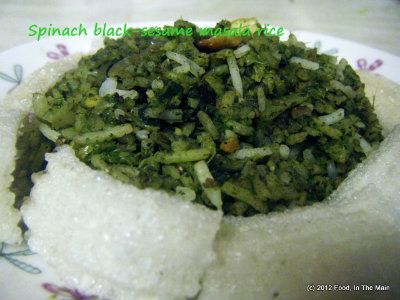
Ingredients:
4-5 cups basmati rice, pre-cooked al dente
1 cup shredded green cabbage (I used savoy)
1 large onion, sliced thinly
2 tbsp chopped mint
1 tbsp oil
1/2 tsp cumin seeds, crushed or left whole
1 tsp ghee
10-15 cashewnuts, broken, for garnish
a pinch of soda bicarb
Salt to taste
For the wet masala
1 cup chopped spinach, loosely packed
1 cup chopped coriander leaves, loosely packed
4-5 green chillies (or as per taste)
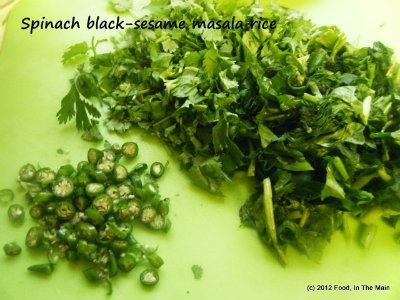
1" piece ginger
For the dry masala
1 tbsp coriander seeds
1 tbsp black sesame seeds
1 tbsp tur dal
2-3 dry red chillies (optional)
Method:
1. Grind all the ingredients for the wet masala to a smooth paste and set aside till required.
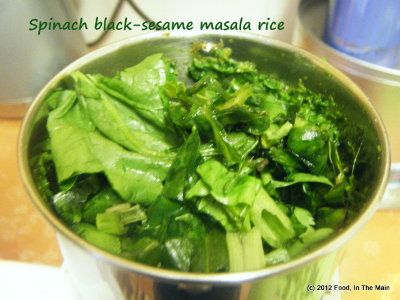
Do not add any extra water while grinding.
2. Dry-roast the dry masala ingredients in a small pan over medium heat,

stirring frequently, till they are aromatic and the dal is golden brown. Do not let them burn. When cool, grind them to a powder (doesn't have to be very smooth) and reserve.
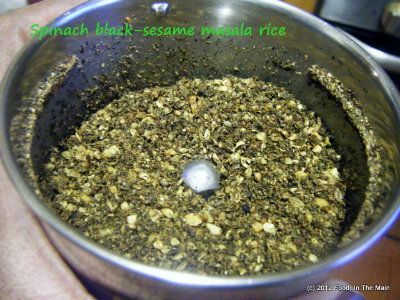
3. Heat the ghee in a big kadai or wok and fry the cashew nuts till they are a pale golden brown. Remove from the pan and set aside till required.
4. In the same pan, heat the 1 tbsp oil. Add 1/2 tsp cumin seeds and let them sizzle for 10 seconds, then add the sliced onion.
5. Fry 2-3 till they begin to soften, then add the cabbage.

Stir well, then cover the pan tightly and let the cabbage cook till nearly done, about 7 minutes.
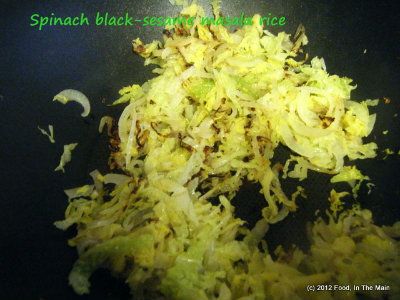
6. Now add the ground spinach masala with a pinch of soda bicarb and fry it for about 5-6 minutes, stirring,
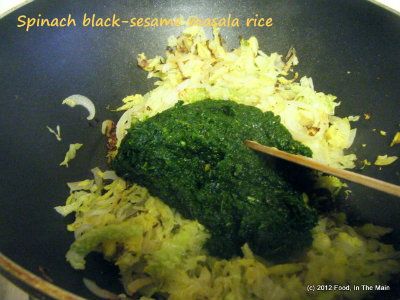
until it loses most of the excess moisture and doesn't smell raw any more.

7. Add the cooked rice now, along with salt to taste,
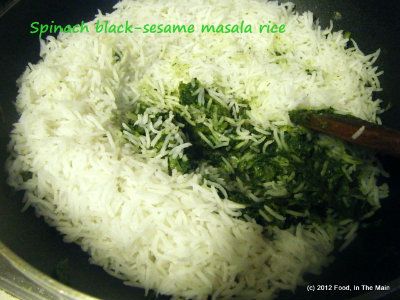
and mix it in carefully with the masala, without mushing up the grains,
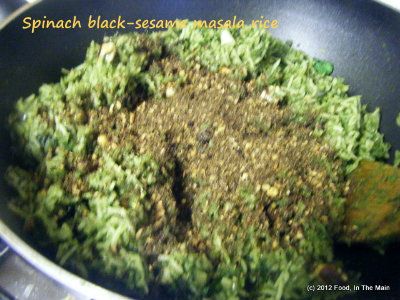
then stir in the dry masala powder.
8. Sprinkle the chopped mint and fried cashewnuts over the rice,
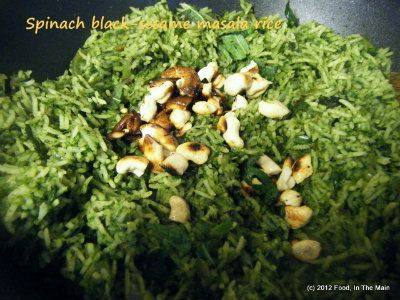
and serve hot along with fried papad/appalam or potato crisps, and onion raita.
RECIPE: SPINACH BLACK-SESAME MASALA RICE
Ingredients:
4-5 cups basmati rice, pre-cooked al dente
1 cup shredded green cabbage (I used savoy)
1 large onion, sliced thinly
2 tbsp chopped mint
1 tbsp oil
1/2 tsp cumin seeds, crushed or left whole
1 tsp ghee
10-15 cashewnuts, broken, for garnish
a pinch of soda bicarb
Salt to taste
For the wet masala
1 cup chopped spinach, loosely packed
1 cup chopped coriander leaves, loosely packed
4-5 green chillies (or as per taste)
1" piece ginger
For the dry masala
1 tbsp coriander seeds
1 tbsp black sesame seeds
1 tbsp tur dal
2-3 dry red chillies (optional)
Method
1. Grind all the ingredients for the wet masala to a smooth paste and set aside till required. Do not add any extra water while grinding.
2. Dry-roast the dry masala ingredients in a small pan over medium heat, stirring frequently, till they are aromatic and the dal is golden brown. Do not let them burn. When cool, grind them to a
powder (doesn't have to be very smooth) and reserve.
3. Heat the ghee in a big kadai or wok and fry the cashew nuts till they are a pale golden brown. Remove from the pan and set aside till required.
4. In the same pan, heat the 1 tbsp oil. Add 1/2 tsp cumin seeds and let them sizzle for 10 seconds, then add the sliced onion.
5. Fry 2-3 till they begin to soften, then add the cabbage. Stir well, then cover the pan tightly and let the cabbage cook till nearly done, about 7 minutes.
6. Now add the ground spinach masala with a pinch of soda bicarb and fry it for about 5-6 minutes, stirring, until it loses most of the excess moisture and doesn't smell raw any more.
7. Add the cooked rice now, along with salt to taste, and mix it in carefully with the masala without mushing up the grains, then stir in the dry masala powder.
8. Sprinkle the chopped mint and fried cashewnuts over the rice, and serve hot along with fried papad/appalam or potato crisps, and onion raita.
Occasionally I buy a bag of “monkey nuts” from the supermarket, because I love me some boiled goobers, I do. Aren’t both those weird terms for peanuts? Monkey nuts are sort of descriptive, therefore understandable - but goobers? I wonder who was the first person who picked up a bunch of the infinity-shaped shells, broke ‘em, took out the red nuts inside and thought “Oh yeah, I know those things! They’re goobers!”
The more you say the "goobers", the more absurd it sounds. But the more absurd it sounds, the more I want to say it, simply because it’s absurd. Eventually I have to stop, though, because people tend to look at me strangely and cross to the other side of the road. I don’t understand why they do that. And when I follow them to explain that I’m merely getting some harmless amusement out of a weird word, they walk away even faster. Strange phenomenon, that...
Anyway, I usually pressure-cook the unshelled peanuts. You can put them in salted water to cook them, but I mostly don’t bother because I like the natural taste of the cooked peanuts hot from the shells. They still taste good when they cool down, don’t get me wrong. I like adding the cold peanuts to salads for texture and protein.
For a change, I made dal with the boiled peanuts. I usually pressure-cook the raw peanuts along with the dal if I’m using tuvar or masoor, where it doesn’t matter if the longer cooking time mushes up the dal entirely. But if chana dal features in the recipe, the peanuts stay separate. Since I’ve used a mixture of masoor and chana dal in this recipe, I cooked the peanuts separately. The reason is that the peanuts take longer to cook than the dals. I like the masoor dal cooked to shapelessness and the chana dal to retain its shape, and putting the two together in a pressure cooker for 3 quick whistles cooks them both just the way I like them. Peanuts don’t figure in this equation, so they get cooked separately.
Now, if we’re all unanimous that I have belaboured that point quite thoroughly, I will move on to the recipe.
Recipe for: Boiled peanut dal
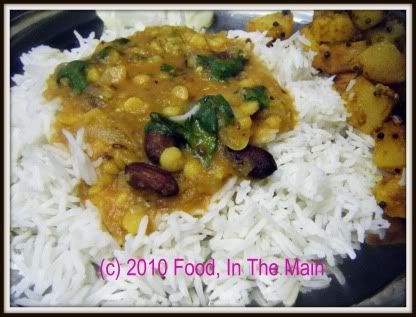 Ingredients:
1/2 cup peanuts, boiled
1/2 cup masoor dal
1/4 cup chana dal
2 small onions, sliced thin
3-4 green chillies (or to taste), sliced in thin strips
1 tsp ginger-garlic paste
1/2 cup roasted tomatoes, mashed
1/2 tsp cumin powder
1 tsp coriander powder
1/4 tsp turmeric powder
1 tsp garam masala/Kitchen King masala
3 tsp oil
Salt to taste
Coriander leaves for garnish
Method:
1. Heat the oil and add the ginger-garlic paste and green chillies. Fry this for 30 seconds, then add the cumin and coriander powder along with the sliced onions.
2. Fry the onions till they start turning soft and translucent. Now add the roasted tomatoes and mash it all with a spatula.
3. Stir-fry the masala for 2-3 minutes, then stir in the boiled peanuts.
Ingredients:
1/2 cup peanuts, boiled
1/2 cup masoor dal
1/4 cup chana dal
2 small onions, sliced thin
3-4 green chillies (or to taste), sliced in thin strips
1 tsp ginger-garlic paste
1/2 cup roasted tomatoes, mashed
1/2 tsp cumin powder
1 tsp coriander powder
1/4 tsp turmeric powder
1 tsp garam masala/Kitchen King masala
3 tsp oil
Salt to taste
Coriander leaves for garnish
Method:
1. Heat the oil and add the ginger-garlic paste and green chillies. Fry this for 30 seconds, then add the cumin and coriander powder along with the sliced onions.
2. Fry the onions till they start turning soft and translucent. Now add the roasted tomatoes and mash it all with a spatula.
3. Stir-fry the masala for 2-3 minutes, then stir in the boiled peanuts.
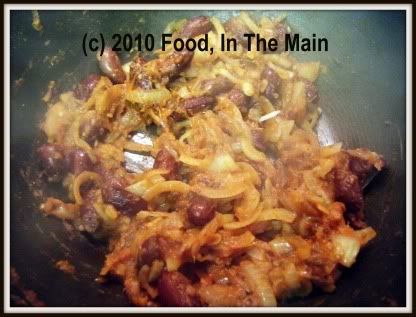 4. Add the cooked dals and mix well. Add 1/3 cup water if the dal seems too thick.
4. Add the cooked dals and mix well. Add 1/3 cup water if the dal seems too thick.
 5. Stir well once again, add salt to taste, and bring the dal to a gentle boil on medium heat.
6. Now sprinkle the garam masala, turn the heat to low and let the dal simmer for 6-7 minutes.
5. Stir well once again, add salt to taste, and bring the dal to a gentle boil on medium heat.
6. Now sprinkle the garam masala, turn the heat to low and let the dal simmer for 6-7 minutes.
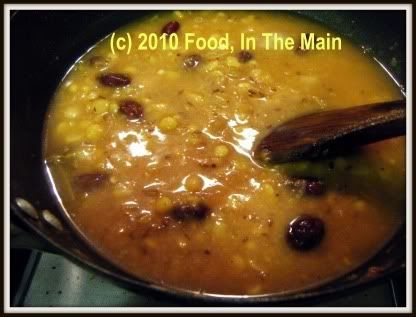 Garnish with coriander leaves and serve hot with rice or rotis.
RECIPE: BOILED PEANUT DAL
Ingredients:
1/2 cup raw peanuts
1/2 cup masoor dal
1/4 cup chana dal
2 small onions, sliced thin
3-4 green chillies (or to taste), sliced in thin strips
1 tsp ginger-garlic paste
1/2 cup roasted tomatoes, mashed
1/2 tsp cumin powder
1 tsp coriander powder
1/4 tsp turmeric powder
1 tsp garam masala/Kitchen King masala
3 tsp oil
Salt to taste
Coriander leaves for garnish
Method:
1. Heat the oil and add the ginger-garlic paste and green chillies. Fry this for 30 seconds, then add the cumin and coriander powder along with the sliced onions.
2. Fry the onions till they start turning soft and translucent. Now add the roasted tomatoes and mash it all with a spatula.
3. Stir-fry the masala for 2-3 minutes, then stir in the boiled peanuts.
4. Add the cooked dals and mix well. Add 1/3 cup water if the dal seems too thick.
5. Stir well once again, add salt to taste, and bring the dal to a gentle boil on medium heat.
6. Now sprinkle the garam masala, turn the heat to low and let the dal simmer for 6-7 minutes. Garnish with coriander leaves and serve hot with rice or rotis.
Garnish with coriander leaves and serve hot with rice or rotis.
RECIPE: BOILED PEANUT DAL
Ingredients:
1/2 cup raw peanuts
1/2 cup masoor dal
1/4 cup chana dal
2 small onions, sliced thin
3-4 green chillies (or to taste), sliced in thin strips
1 tsp ginger-garlic paste
1/2 cup roasted tomatoes, mashed
1/2 tsp cumin powder
1 tsp coriander powder
1/4 tsp turmeric powder
1 tsp garam masala/Kitchen King masala
3 tsp oil
Salt to taste
Coriander leaves for garnish
Method:
1. Heat the oil and add the ginger-garlic paste and green chillies. Fry this for 30 seconds, then add the cumin and coriander powder along with the sliced onions.
2. Fry the onions till they start turning soft and translucent. Now add the roasted tomatoes and mash it all with a spatula.
3. Stir-fry the masala for 2-3 minutes, then stir in the boiled peanuts.
4. Add the cooked dals and mix well. Add 1/3 cup water if the dal seems too thick.
5. Stir well once again, add salt to taste, and bring the dal to a gentle boil on medium heat.
6. Now sprinkle the garam masala, turn the heat to low and let the dal simmer for 6-7 minutes. Garnish with coriander leaves and serve hot with rice or rotis.
This is the recipe which changed my mind about the tasteworthiness of flaxseeds/linseeds and convinced me that these seeds have a permanent place in my kitchen.
I understand these seeds are chemically stable in seed form and keep well without going rancid, but flaxseed oil goes rancid quickly. What I don't know, however, is how long they keep after being roasted and powdered. But I figure that if you make this podi (powder) in small batches, it should get around any potential problems of rancidity.
Oh, and a cautionary note on the pack of flax seeds I bought: Please ensure that you drink at least 150ml water extra per tbsp of flax seeds you consume, as they can cause constipation (especially if you don't normally drink plenty of water in the course of your day, I guess). I should think, however, that if you use a tbsp - or even two - of the paruppu podi with rice for a single portion, the flax seeds should not interfere with the digestion because of the other ingredients that also go to make up the powder.
Try this podi mixed with hot cooked rice and a dollop of ghee... ahhh, heaven!
Recipe for: Flax seed/linseed paruppu podi
Ingredients:
1/4 cup tur dal
1/8 cup urad dal
1/8 cup chana dal
1/8 cup golden flax seeds
5-6 dried red chillies
3/4 tsp black peppercorns
1/4 tsp cumin seeds
10 fresh or frozen curry leaves
1/4 tsp asafoetida powder
Salt to taste
1. Dry roast the chana dal and tuvar dal together with the dried red chillies till they turn aromatic and pale golden brown and the red chillies are a darker shade.
2. Dry roast the urad dal, golden flax seeds, black pepper corns, curry leaves and cumin seeds till the seeds are golden brown and the curry leaves are crisp
3. Let all the dals and seeds cool completely, then grind to a powder that is the texture of fine sand. Add salt to taste and mix well. Store in a clean dry jar.
Years ago, when my dad was based in Srinagar with me and my siblings studying in Madras, my mother used to shuttle between the two cities. I’m guessing she was torn between wanting to take care of us in Madras – I was in the first year of college and my sister and brother still in school – and being with my dad whose health was not good at the time.
It was a fairly odd sort of arrangement for us, because we kids lived with our maternal grandparents in their large home… except that we occupied the upstairs and they lived in the downstairs portion. My grandmother would cook for herself and my granddad, as they were very orthodox and did not believe – quite rightly, too – that I could maintain their high standards of “patthu” and “yecchal” and all the rest of the overdone Brahmin Iyer kitchen rituals. My grandparents might also have suspected that I couldn’t be bothered about observing any of it… something that they could not accept for themselves.
Also, our school and college timings and my granddad’s morning puja rituals (with my grandma cooking food only after her morning bath, and that food allowed to be eaten only after the puja was over) were totally incompatible – if we had waited for all that to take place every morning, getting to school on time would have been impossible.
Whatever the reason, therefore, I had use of the kitchen upstairs to cook basic stuff for me and my sibs, with my grandma providing things like sambar or kootu or whatever took her fancy.
So, every time before my mother left for Srinagar, she would make some fridge staples to last us a few weeks and save me having to cook anything more than the basic rice and dal – I was not particularly enthusiastic about kitchen duties at that point. One of the things she made was black pepper vattha kuzhambu– but in concentrated form, like pulikachal. Anytime I wanted a quick kuzhambu, all I had to do was boil up some tamarind water, dissolve 2-3 tbsp of the concentrate in it – and voila! The gravy was ready in a jiffy.
This recipe that I came across reminded me strongly of that long-ago milagu kuzhambu, so I decided to make it, to see if it was anything like that in my memory. And do you know what… it was actually exactly like my mom didn’t make! (sorry about the anticlimax). :o) But… it was fiery and aromatic and a little of it was plenty for one meal, so it lasted me ages in the fridge. I thoroughly recommend this milagu kuzhambu to anybody who likes the hot peppery taste generated by plenty of hot black peppercorns supplemented with some dried red chillies. That, some hot plain rice, a dollop of ghee and – yes, yes, yes, always the pan-fried potatoes for perfect nostalgia and a satisfying meal… ahhhh…
Recipe for: Milagu kuzhambu
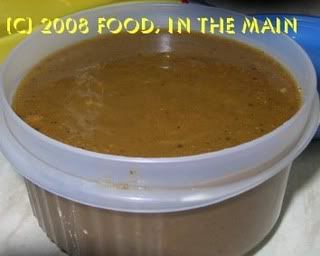
Ingredients:
2 tbsp black peppercorns
2 tbsp cumin seeds
2 tbsp tur dal
2 tbsp coriander seeds
1/4 tsp asafoetida powder
12-15 curry leaves
4-5 dried red chillies
1 htsp tamarind paste
Salt to taste
2 tsp oil (Nallennai for preference)
1/4 tsp turmeric powder
1/2 tsp mustard seeds
1/2 tsp urad dal
Salt to taste
Water as required
Method:
1. Heat 1/2 tsp oil in a pan, add the peppercorns, cumin seeds, coriander seeds, tur dal, curry leaves and red chillies and fry on medium heat. Take the pan off the heat when the dal turns golden and let it cool.
2. Grind the roasted ingredients to a fine powder. Then add 1/2 cup water along with the tamarind paste and grind to a homogenous masala paste. It will thicken quite quickly, so add a little more water as required to make it thick and pourable.
3. Heat the remaining oil in the pan, add the mustard seeds and urad dal, cover the pan and let the seeds pop on high heat for a 30-60 seconds. Add the asafoetida powder now along with the turmeric powder.
4. Dissolve the masala paste in 1-1/2 cups water and pour into the pan. Add salt to taste and stir.
5. Let the kuzhambu come to a boil (add water if it is too thick, but dont make the kuzhambu runny), then simmer on medium heat for 5 minutes.
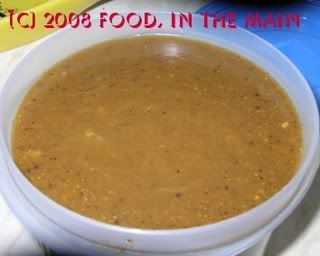
Serve hot with steamed rice, a serving of cooked tur dal if you like, and a topping of ghee. Mix, eat and immediately enter pepper heaven.
This kuzhambu stays good for a couple of weeks in an airtight container kept in the fridge. Use a clean dry spoon every time.
This has been possibly one of the tastiest dals I've made - and I'm not sure what gave it that extra oomph. I'm aware this is not the most inspiring of things for any cook to say... I mean, if a cook doesnt know what makes his/her recipe a hit, who would?
Still, as I said - no idea what made the dal stand out, especially as the ingredients used were (are) absolutely standard. All I can think of is that perhaps it was the sorrel, as freshly harvested as any greens could get, that made the difference. I got the leaves from my container garden two minutes before I used them. I also had a cupful of water left over from cooking green beans for Pete, so I added that to the dal instead of plain water - but I cant see that it would have made much difference. Bean cooking water is just bean cooking water, not a flavour developer. Right?
I've always thought that sorrel was the English name for gongura, the sour greens so typically used in Andhra cooking. Since I havent actually seen gongura (except in the finished dish made by someone else!) or cooked with it before, I just assumed my sorrel was gongura. Only, my mother said it couldnt be gongura because the leaves werent the right shape (this was when they were just beginning to grow).
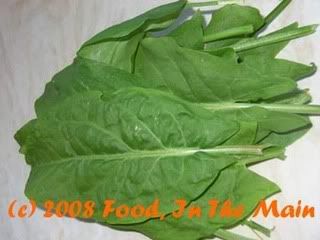
True enough, the leaves were broad and flat rather than narrow and tapered... but they were sour. Not mouth-puckeringly so, but with a pleasant sort of sourness, rather like tamarind leaves. Since they were green and sour, I christened them gongura, and made the dal that I've been hankering after ever since I had it first at a friend's place, many many MANY moons ago. Dont anybody tell me it's not gongura... because my response will only be this: "It's a different KIND of gongura, so there."
So there.
Recipe for: Sorrel dal
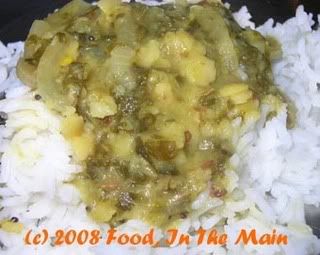
Ingredients:
1 cup tur dal, cooked
2 cups gongura leaves, washed and sliced
1 medium onion, minced
1 tsp ginger, grated
3-4 fresh green chillies (or to taste), sliced very thin
2 tsp oil
1 tsp coriander powder
1 tsp mustard seeds
1 tsp cumin seeds
1 tsp ghee
1-2 dry red chillies
Salt to taste
1-1/2 cups water
Method:
1. Heat the oil in a pan, add the mustard seeds, cover and let them pop. Then add the ginger, green chillies and coriander powder and fry for 30 seconds or so.
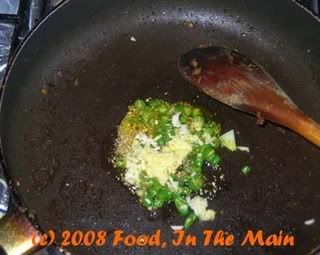
2. Throw in the onions and saute them till they begin to soften and become pale brown.
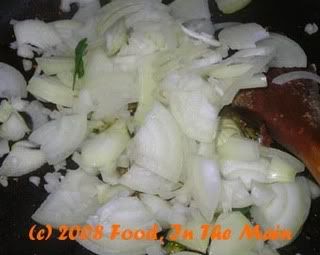
3. Now add the sorrel leaves and stir till they begin to wilt.
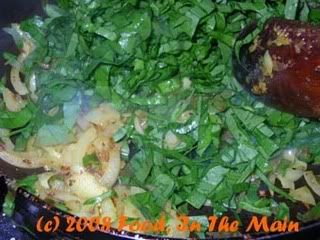
4. Pour in the water
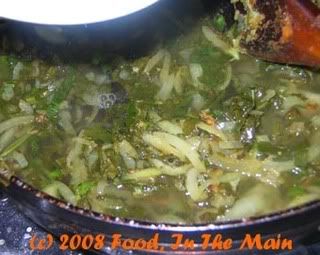
and let it simmer for 4-5 minutes.
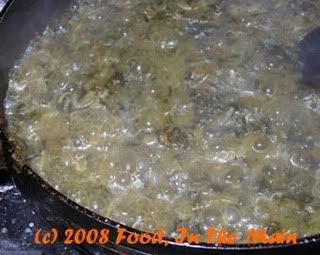
5. Then add the cooked tur dal and salt to taste, and stir.
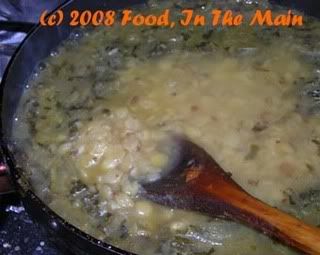
Let the dal come to a gentle bubbling simmer.
6. In the meanwhile, heat 1 tsp ghee in a small pan. Break the dry red chillies in two or three pieces and add them to the ghee. Then add the cumin seeds and let them fry for 30 seconds till fragrant and brown.
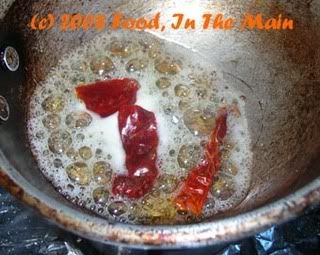
Pour this tempering on the dal and mix.
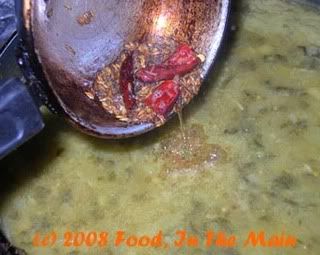
Serve hot over rice or with chapaties.
Since one of my favourite bloggers, Linda of "Out of the Garden", extended the last submission date for JFI: Toor dal to December 7, I thought I would take the opportunity to submit one more recipe for the round-up. I feel quite pleased with myself - it isnt often I get (ok, or give myself) the chance to make more than one recipe for a food event.
Anyway, I had a cup of tur dal which I'd cooked, left in the pressure cooker and forgotten about for an entire night and day. I'd decided to make mor kuzhambu (a buttermilk-based "gravy" for plain rice) when I (re)discovered the tur dal lurking in the pressure cooker. So to circumvent the process of putting the tur dal in a container in the fridge and using it another day, I just whisked the tur dal into the buttermilk mixture. I liked the fact that the tur dal did a good job of preventing the buttermilk from splitting when heated - I didnt push my luck by bringing it to a boil, but I certainly managed to heat it more thoroughly than if it had been just plain buttermilk without the dal.
And yes, it tasted fine.
Recipe for: Tur dal mor kuzhambu

Ingredients:
1 cup cooked tur dal, mashed (I left a spoonful unmashed for texture)
4 cups thick buttermilk + 1/2 cup water
4 tbsp grated coconut
4-5 fresh green chillies (or to taste)
1/2 tsp cumin seeds
small marble sized piece of tamarind or 1/2 tsp tamarind paste
Salt to taste
1 tsp mustard seeds
1 tsp oil
Good pinch of asafoetida powder
a few fresh curry leaves (optional)
Method:
1. Grind the coconut, green chillies, cumin seeds and tamarind to a smooth paste using hot water as required.
2. Whisk the cooked tur dal into the buttermilk + water till well mixed.
3. Then whisk in the ground coconut mixture along with salt to taste.
4. Heat the oil in a saucepan, add the mustard seeds, curry leaves and asafoetida powder. Cover and let the mustard seeds pop.
5. Pour in the buttermilk kozhambu mix into the pan carefully, stirring all the while.
6. Heat it through without letting it come to a boil.
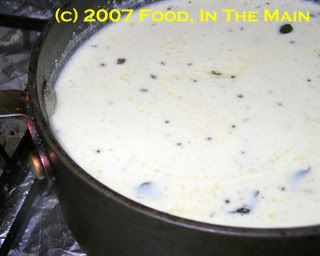
Serve hot with plain white rice and any vegetable curry.
There's a classic accompaniment to vattha kuzhambu that my mother used to make for my dad, years and years ago, when we lived in Tanzania. It's called "paruppu thogayal", a bland (in the sense of no chillies being added) chutney made of roasted tur dal. Since vattha kuzhambu isnt made with the addition of cooked tur dal, this chutney was a way of adding protein to the meal. I dont remember if I loved the chutney as much as my dad, but since my mother hasnt made it in years (since Tanzania, if memory serves me right), we kids cant have been that fond of it.
Anyway, I've never made it before nor seen how it was made, so I didnt quite know the method. I was looking for recipes using tur dal for Linda's JFI Tur Dal event when I came across a "tur dal thuvayal" recipe on the Net - I think it was on the ForumHub site, but for the life of me I cant find that chat link again!

Top: Moong dal; Bottom: Tur Dal
Anyway, apart from the main item, Tur Dal, it called for red chillies, raw garlic and some moong dal - these three ingredients completely threw me off the scent, as it were. I didnt think it was a variation of the paruppu thogayal my mother used to make... until it came to grinding the roasted dal. Then the aroma instantly made itself the familiar yet long-forgotten one of paruppu thogayal.
Since I used raw garlic, red chillies and moong dal to make this chutney, it wasnt quite my mother's version. Call it a grown-up version, if you will. I cant say that I fell in love with this version any more than I did with the original... but it wasnt bad either. It's just that the roasted tur dal flavour is VERY intense. Of course this is only my personal opinion of the chutney... chances are there are people who slaver just at the thought of it! So here it is, my entry for JFI - Tur Dal.
Recipe for: Tur dal chutney
1 tsp payatham paruppu (moong dal)
1/4 cup thuvaram paruppu (tur dal)
5-6 dried red chillies (or to taste)
3 garlic pearls
1/2 tsp oil
salt to taste
Water as required
Method:
1. Heat the oil and fry the dals and red chillies separately over a medium flame, stirring constantly.
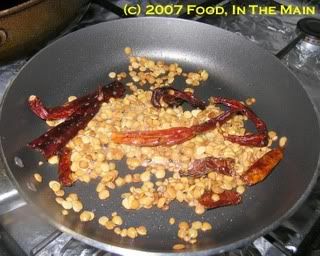
The dals should be golden brown (take care not to burn them) and the red chillies should turn darker in colour. Let cool completely.
2. Grind the fried dals, chillies, garlic with 4-5 tablespoons of water to a smooth paste.

Dont worry about adding more water - the chutney solidifies quite a bit after grinding as it absorbs the water.
3. Add salt to taste and mix well. This can be served with rice and ghee or as a side with dosas or idlis.


































